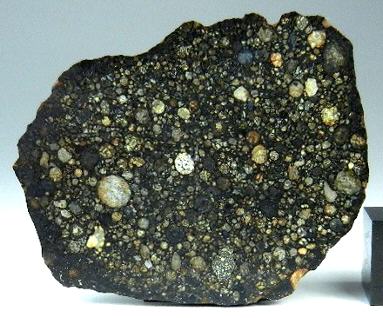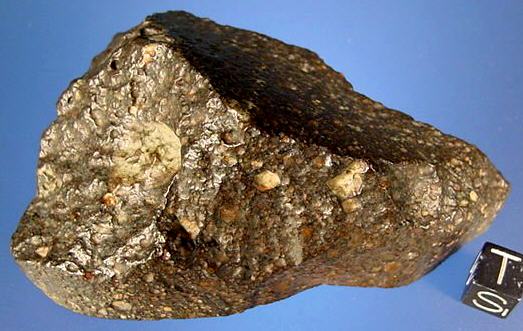L3.2

Purchased 2005
no coordinates recorded Three conjoint fragments of an unequilibrated chondriteA chondrite with heterogeneous mineral compositions (e.g., olivine grains with differing FeO/(FeO+MgO) ratios., having a combined weight of 1,805 g, were found in the Sahara Desert and sold to G. Hupé in Erfoud, Morocco. This meteoriteWork in progress. A solid natural object reaching a planet’s surface from interplanetary space. Solid portion of a meteoroid that survives its fall to Earth, or some other body. Meteorites are classified as stony meteorites, iron meteorites, and stony-iron meteorites. These groups are further divided according to their mineralogy and Click on Term to Read More was analyzed and classified at Northern Arizona University (J. Wittke and T. Bunch) as an L-type ordinary chondriteWork in Progress Ordinary chondrites (OCs) are the largest meteorite clan, comprising approximately 87% of the global collection and 78% of all falls (Meteoritical Society database 2018)1. Meteorites & the Early Solar System: page 581 section 6.1 OC of type 5 or 6 with an apparent shock stage of S1, Click on Term to Read More.
A new petrologic scheme that is more discriminating at the lowest
metamorphicRocks that have recrystallized in a solid state due to changes in temperature, pressure, and chemical environment. Click on Term to Read More stages, those associated with the highly unequilibrated
chondritesChondrites are the most common meteorites accounting for ~84% of falls. Chondrites are comprised mostly of Fe- and Mg-bearing silicate minerals (found in both chondrules and fine grained matrix), reduced Fe/Ni metal (found in various states like large blebs, small grains and/or even chondrule rims), and various refractory inclusions (such Click on Term to Read More (3.0–3.2), was developed by Grossman (2004), Grossman and A. Brearley (2005), and Grossman (2008). This new classification scheme is based in part on a sensitive analytical technique utilizing the variation in the distribution of Cr in ferroan
olivineGroup of silicate minerals, (Mg,Fe)2SiO4, with the compositional endpoints of forsterite (Mg2SiO4) and fayalite (Fe2SiO4). Olivine is commonly found in all chondrites within both the matrix and chondrules, achondrites including most primitive achondrites and some evolved achondrites, in pallasites as large yellow-green crystals (brown when terrestrialized), in the silicate portion Click on Term to Read More, and it is virtually unaffected by the processes of terrestrial weathering and aqueous alteration. The petrologic scale of the new decimal
systemDefinable part of the universe that can be open, closed, or isolated. An open system exchanges both matter and energy with its surroundings. A closed system can only exchange energy with its surroundings; it has walls through which heat can pass. An isolated system cannot exchange energy or matter with has been extended as follows:
3.00–3.05–3.10–3.15–3.2
For metamorphic types 3.00–3.03,
chromiteBrownish-black oxide of chromium and iron (Cr-Fe oxide), Cr2FeO4, found in many meteorite groups. Click on Term to Read More contents account for 0.3–0.5 wt% in the
chondriteChondrites are the most common meteorites accounting for ~84% of falls. Chondrites are comprised mostly of Fe- and Mg-bearing silicate minerals (found in both chondrules and fine grained matrix), reduced Fe/Ni metal (found in various states like large blebs, small grains and/or even chondrule rims), and various refractory inclusions (such Click on Term to Read More groups studied. While chromite contents in type 3.05–3.10 chondrites still reflect the lowest degrees of metamorphism, at a degree of metamorphism equivalent to type 3.15 the chromite abundance has declined to only 0.1–0.2 wt%. With metamorphic types of at least 3.2, the chromite abundance is mostly less than 0.1 wt%. Northwest Africa 2798 has a measured Cr content in olivine of 0.21 (±0.09) wt%, and with consideration of other parameters, has been assigned to subtype L3.2. It has a
shock stageA petrographic assessment, using features observed in minerals grains, of the degree to which a meteorite has undergone shock metamorphism. The highest stage observed in 25% of the indicator grains is used to determine the stage. Also called "shock level". Click on Term to Read More of S2 and a low weathering grade of W1. The specimen of NWA 2798 pictured above is a 6.13 g complete slice.

Photo courtesy of Greg Hupé








